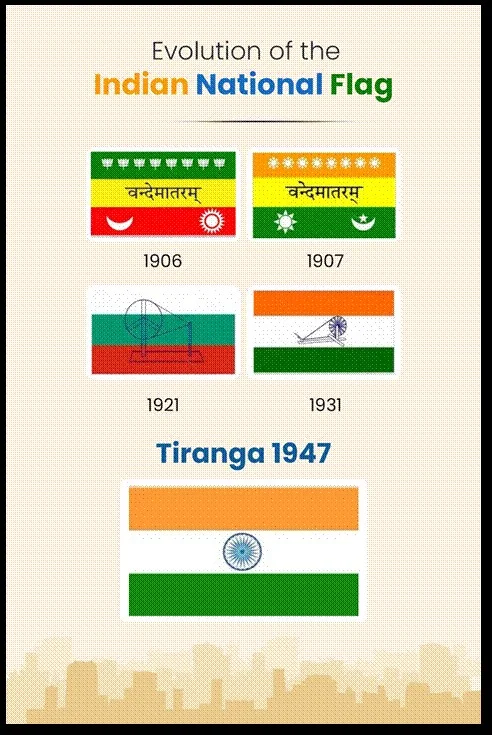Important Facts For Prelims
National Flag Day 2025
- 22 Jul 2025
- 7 min read
Why in News?
India observed National Flag Day (Tiranga Adoption Day), on 22nd July 2025, to mark the anniversary of the Indian National Flag's official adoption by the Constituent Assembly in 1947.
What are the Key Facts About the Indian National Flag?
- Evolution of the Indian National Flag:
- 1904: Designed by Sister Nivedita, it featured red and yellow with a Vajra (strength), a white lotus (purity), and "Bande Mataram" inscribed.
- Sister Nivedita was an Irish social activist and a disciple of Swami Vivekananda.
- 1906 (Swadeshi Movement Flag): Considered the first tricolour, it was hoisted in Calcutta with green, yellow, and red horizontal stripes. It featured lotuses, a sun, a crescent moon, and the words "Vande Mataram".
- 1907 (Saptarishi Flag): Hoisted by Madam Bhikaji Cama in Germany. It had green, saffron, and red stripes with lotuses, "Vande Mataram", a sun, and a crescent moon.
- 1917 (Home Rule Movement Flag): Introduced by Annie Besant and Tilak. It had red and green stripes, the Union Jack, crescent and star, and stars in the Saptarishi pattern.
- 1921: Pingali Venkayya (an Indian freedom fighter, linguist, and polymath from Andhra Pradesh), proposed a red, white, and green flag with a spinning wheel, symbolising unity and self-reliance. The design of the present Indian flag is largely attributed to him.
- In 1931 Saffron replaced red. The flag had saffron, white, and green with a spinning wheel in the centre. It was adopted by the Indian National Congress.
- 1947 (Present Flag): Adopted by the Constituent Assembly. The spinning wheel was replaced with the Ashoka Chakra.
- 1904: Designed by Sister Nivedita, it featured red and yellow with a Vajra (strength), a white lotus (purity), and "Bande Mataram" inscribed.
- Common name: Tiranga, meaning Tricolour.
- Design: Three horizontal stripes: saffron (kesari) (top), White (middle), Green (bottom), with a navy blue Ashoka Chakra in the centre.
- Ashoka Chakra: The Ashoka Chakra, with 24 spokes, is based on the wheel from the Sarnath Lion Capital made by the 3rd-century BC Mauryan Emperor Ashoka and fits within the width of the white band.
- Symbolism:
- Saffron: Strength and Courage of the Country.
- White: Purity, Truth, and Peace.
- Green: Fertility, growth, and prosperity, reflecting India’s agricultural roots and environmental commitment.
- Ashoka Chakra (known as the “wheel of law”): Represents Law, justice, and the cycle of life. The chakra intends to show that there is life in movement and death in stagnation.
- Flag dimensions: 3:2 ratio (length to height).
- Regulation: Governed by the Flag Code of India, 2002 which sets rules for display, handling, and respect for the flag.
- Article 51A(a) of the Indian Constitution mandates that it is the fundamental duty of every citizen to respect the National Flag and National Anthem.
- The Prevention of Insults to National Honour Act, 1971, punishes offences related to disrespecting the national flag or anthem.
- Material: Traditionally made from hand-spun khadi (cotton), symbolising self-reliance. In 2021, the Flag Code of India, 2002 was amended to allow the national flag to be made from other approved materials, including machine-made and polyester flags.
Note: The National Flag in possession of the Archaeological Survey of India at Fort St George Museum in Chennai is known as the oldest surviving Indian national flag. It was hoisted at Fort St George in Chennai on 15th August 1947.
What is the Flag Code of India, 2002?
- About: The Flag Code of India, 2002, came into effect on 26th January 2002, allowing citizens to hoist the national flag at their homes, offices, and factories on any day, not just on national occasions provided they follow the code's rules.
- The Code is divided into three parts: Part I describes the flag, Part II covers its use by the public and institutions, and Part III outlines its display by government bodies.
- Flag Code outlines the Do's and Don'ts to preserve the dignity and honour of the national flag.
- The Flag Code of India was amended in 2022 to allow the national flag to be flown day and night if displayed in the open or on a private home. Earlier, it was only allowed between sunrise and sunset. The change came ahead of the Har Ghar Tiranga campaign under Azadi Ka Amrit Mahotsav.
- The Do's: The flag may be hoisted in schools and other institutions to promote respect.
- Citizens, private groups, and institutions can display the flag on any day, with dignity.
- It grants all citizens the right to fly the flag on their premises.
- The Don'ts: The flag cannot be used for communal gains, drapery, or clothes.
- The flag cannot be intentionally allowed to touch the ground or the floor or trail in water. It cannot be draped over the hood, top, and sides or back of vehicles, trains, boats or aircraft.
- No other flag, object, or decoration should be placed above or on the flag.
UPSC Civil Services Examination, Previous Year Question (PYQ)
Q. Who among the following is associated with ‘Songs from Prison’, a translation of ancient Indian religious lyrics in English? (2021)
(a) Bal Gangadhar Tilak
(b) Jawaharlal Nehru
(c) Mohandas Karamchand Gandhi
(d) Sarojini Naidu
Ans: (c)
Q. What is the number of spokes in the Dharmachakra in the National Flag of India? (2008)
(a) 16
(b) 18
(c) 22
(d) 24
Ans: (d)







